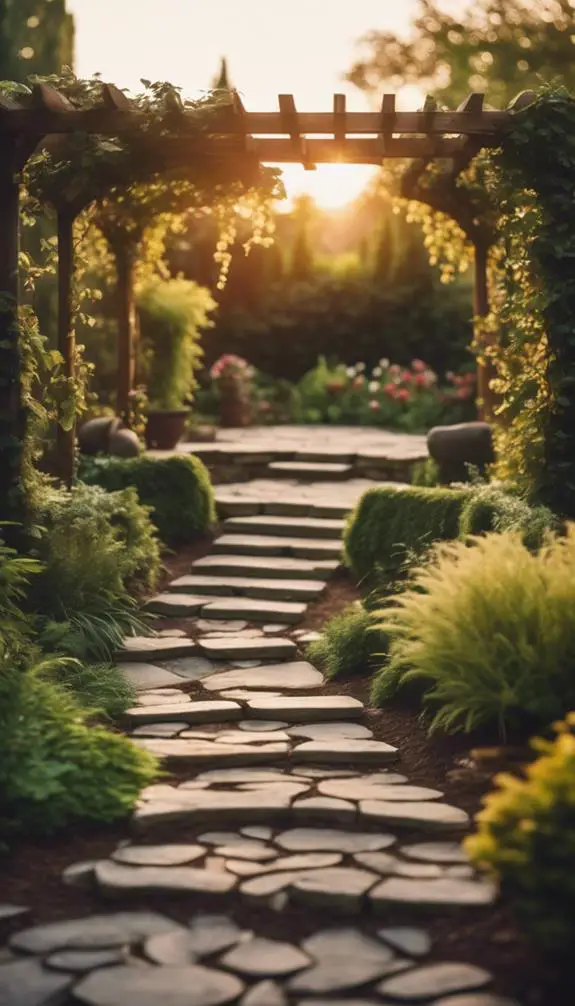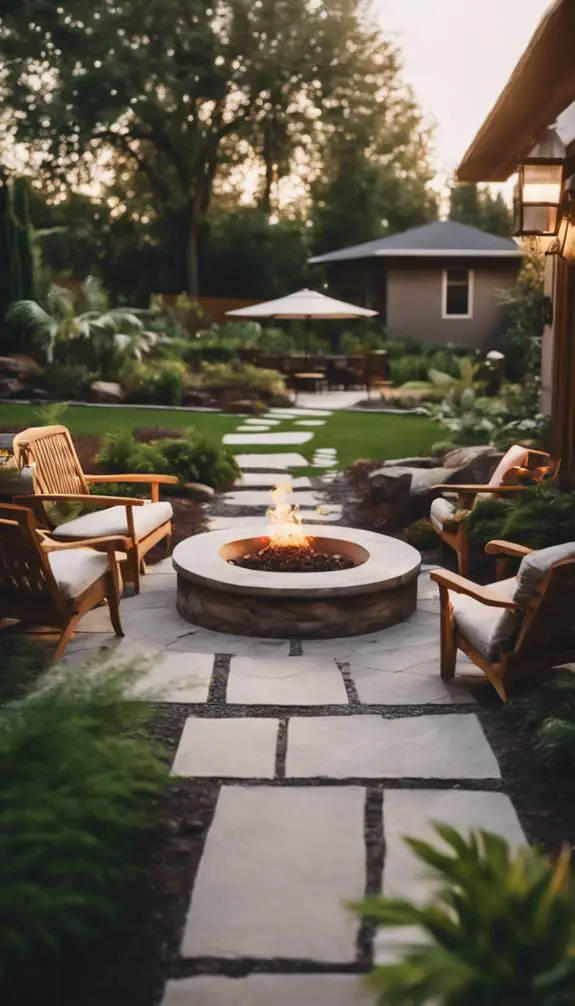As you step into your backyard, you're likely envisioning a space that's both beautiful and functional. But before you can start building your outdoor oasis, you need a solid design layout. This is where the real planning begins. You've got to ponder the site's strengths and weaknesses, from the sun's path to the soil's quality. By taking the time to assess your yard's conditions and set a realistic budget, you'll be able to create a space that perfectly blends your wants and needs. But that's just the beginning – and it's where things are about to get really interesting.
Summary
- Conduct a thorough site analysis to identify yard strengths and weaknesses, noting sun path, wind direction, and soil quality.
- Create a yard map to visualize the space, identifying areas of full sun, partial shade, and full shade, and document natural drainage patterns.
- Define the aesthetic by identifying colors, textures, and forms that resonate, and divide the backyard into distinct zones by purpose.
- Strike a harmonious balance between hardscapes and softscapes, integrating structural elements and blending plants, trees, and flowers.
- Harness natural sunlight by understanding daily sun rotations and patterns, placing plants accordingly, and creating a sense of flow through visual pathways.
Assessing Your Yard's Conditions
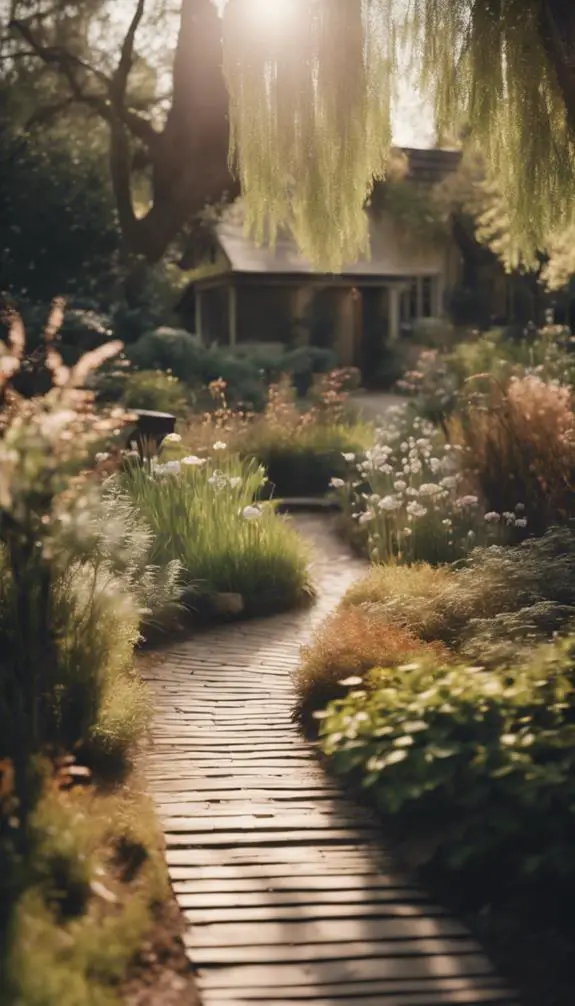
As you step into your yard, take stock of the existing conditions that will impact your design.
Conduct a thorough site analysis to identify the yard's strengths and weaknesses. Take note of the sun's path, wind direction, and soil quality.
Yard mapping will help you visualize the space, revealing areas that receive full sun, partial shade, or full shade. Observe the natural drainage patterns and any existing water features.
Document the location of utility lines, septic systems, and other underground infrastructure. Measure the yard's dimensions, including any slopes or grades.
Setting a Realistic Budget
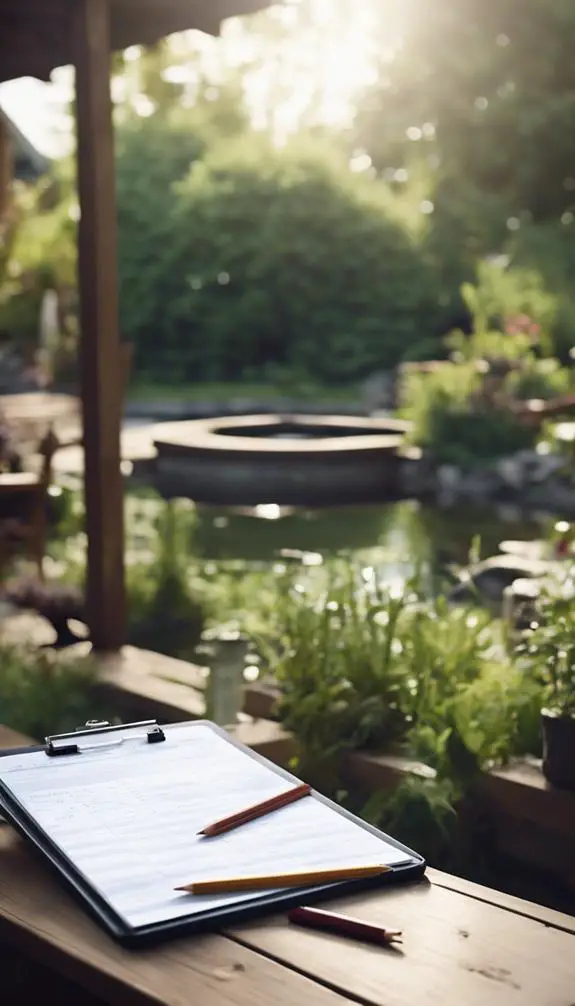
With your yard's conditions thoroughly assessed, you're now ready to establish a financial framework for your design project.
To set a realistic budget, you'll need to prioritize your wants and needs, allocating funds accordingly. Consider budget tracking tools to monitor expenses and stay on course.
Identify areas for cost cutting, such as repurposing existing features or using sustainable materials. Be prepared to make compromises, but don't sacrifice overall aesthetic and functionality.
A well-planned budget will guarantee your design vision becomes a reality, without breaking the bank. By setting a realistic budget, you'll avoid financial stress and enjoy the process of transforming your outdoor space.
Determining Your Outdoor Style

You'll need to define your aesthetic by identifying the colors, textures, and forms that resonate with you.
Consider your outdoor living needs, such as whether you'll be hosting large gatherings or creating a peaceful retreat.
Define Your Aesthetic
Defining your aesthetic is a crucial step in creating a backyard that reflects your personality and complements your lifestyle.
You'll want to pinpoint what inspires your design decisions, whether it's modern sleekness, rustic charm, or a fusion of styles.
Consider your personal taste and the architectural style of your home.
Collect design inspiration from various sources like magazines, social media, or nature itself.
Identify the elements that resonate with you, such as color schemes, textures, and shapes.
Create a visual board or digital collection to organize your ideas and get a sense of what works together.
Outdoor Living Needs
How will you live in your outdoor space? Will you host family gatherings, engage in outdoor activities, or simply relax and unwind?
Determining your outdoor style begins with identifying your needs. Consider the types of activities you want to do in your backyard.
Do you need a dedicated area for outdoor dining or a space for kids to play? Think about the frequency and size of gatherings you'll host. This will help you decide on the ideal layout and features for your outdoor space.
Personalize Your Space
Your outdoor style is a reflection of your personality, and it begins to take shape as you envision the ambiance you want to create.
Consider the activities you'll be doing in your backyard, from lounging to entertaining, and how you want to feel in each space.
Do you crave private sanctuaries or vibrant outdoor retreats?
Think about the colors, textures, and materials that resonate with you, and how they'll interact with natural elements like light, water, and foliage.
As you weigh these factors, your unique style will emerge, guiding your design decisions and transforming your backyard into a bespoke oasis that mirrors your individuality.
Creating a Functional Zone

You'll define each zone by its purpose, whether it's for entertainment, relaxation, or recreation, to guarantee a cohesive and functional outdoor space.
Next, you'll analyze the functionality flow between zones, considering how people will move through the space and interact with each other.
Zone Definition Purpose
By dividing your backyard into distinct zones, you can create a functional and efficient outdoor space that meets your specific needs and preferences.
This zone planning approach allows you to allocate areas for different activities, ensuring a purposeful segregation of spaces. Define each zone's purpose by identifying how you'll use it, such as relaxation, entertainment, or recreation.
Consider the activities you'll be doing in each zone and the elements needed to support them. For instance, a dining zone might require a patio, seating, and lighting, while a play zone might need a lawn, playground equipment, and shade structures.
Functionality Flow Analysis
Harmony in a backyard design emerges when each zone flows seamlessly into the next, allowing for effortless shifts between activities.
To achieve this, you'll need to analyze the functionality flow of your yard. Start by identifying the activities you want to incorporate, such as dining, lounging, and gardening.
Then, cluster these activities into functional zones using activity clustering. This will help you visualize how each zone will interact with the others.
Next, create a functionality mapping to determine the ideal layout for each zone. Consider the flow of traffic, sightlines, and how each zone will segue into the next.
Balancing Hardscapes and Softscapes

When designing your backyard, finding a balance between hardscapes and softscapes is crucial to creating an aesthetically pleasing and functional outdoor space.
You'll want to strike a harmonious balance between the two, ensuring that neither element overpowers the other.
Achieving hardscape balance involves thoughtfully integrating structural elements like patios, walkways, and retaining walls into your design.
Meanwhile, softscape harmony is all about blending plants, trees, and flowers in a way that complements your hardscapes.
By balancing these two elements, you'll create a cohesive, visually stunning space that invites relaxation and recreation.
Selecting the Right Materials

When selecting materials for your backyard design, you're making a long-term investment, so it's vital to weigh longevity matters, such as how well they'll withstand the elements and heavy use.
The right textures will also greatly impact the overall aesthetic, from the roughness of natural stone to the smoothness of porcelain pavers.
Material Durability Matters
You'll want to factor in the long-term implications of your backyard design, taking into account the wear and tear that comes with exposure to the elements.
Material durability matters, and it's vital to select materials that can withstand the test of time. Conduct material testing to determine the durability ratings of various options.
Look for ratings that indicate resistance to UV degradation, moisture absorption, and temperature fluctuations. Consider materials with high durability ratings, such as weather-resistant woods, durable composites, or low-maintenance metals.
Picking the Right Textures
Across your backyard design, a harmonious balance of textures can elevate the aesthetic appeal and create a unique sensory experience.
You'll want to combine contrasting textures to add depth and visual interest. Rough hardscapes like stone or brick can provide a striking backdrop for smooth, lush greenery.
In cozy corners, incorporate soft, plush textiles like outdoor rugs and pillows to create inviting nooks. Consider the feel of weathered wood or rusty metal accents to add warmth and character.
Budget-Friendly Options Exist
The quest for budget-friendly options begins with selecting the right materials.
You'll want to prioritize those that offer durability and low maintenance without breaking the bank. Consider repurposing items you already have, like turning old pallets into planters or upcycling broken pottery into a mosaic.
For new purchases, opt for affordable yet stylish choices like composite decking or recycled stone.
Create a budget breakdown to allocate funds wisely, allocating the most to essential elements like hardscaping and structural components.
A little creativity can go a long way in your yard revamp, and with careful planning, you can achieve a stunning outdoor space without overspending.
Incorporating Outdoor Lighting
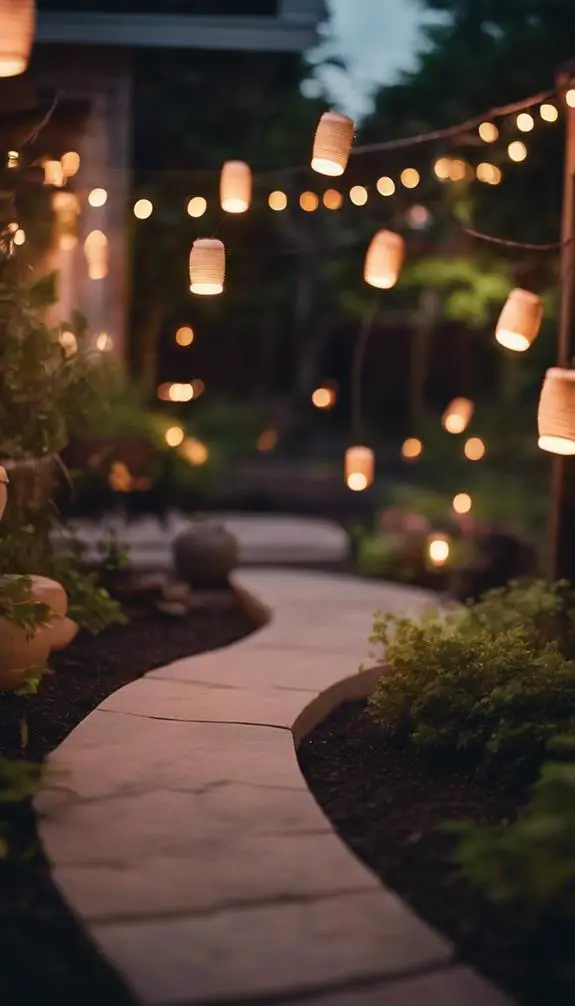
About 70% of your backyard's ambiance is defined after dark, making outdoor lighting a crucial aspect of your overall design.
You'll want to create a visually appealing space that's both functional and safe. Ambient illumination is key, as it sets the tone for your outdoor space.
Consider LED landscaping lights to highlight specific features, such as walkways, gardens, or architectural elements. These energy-efficient lights are durable and require minimal maintenance.
Strategically place them to create pools of light, drawing attention to your backyard's best features. By incorporating outdoor lighting, you'll extend your outdoor living hours and create a warm, inviting atmosphere that's perfect for relaxation or entertainment.
Designing for Drainage and Water
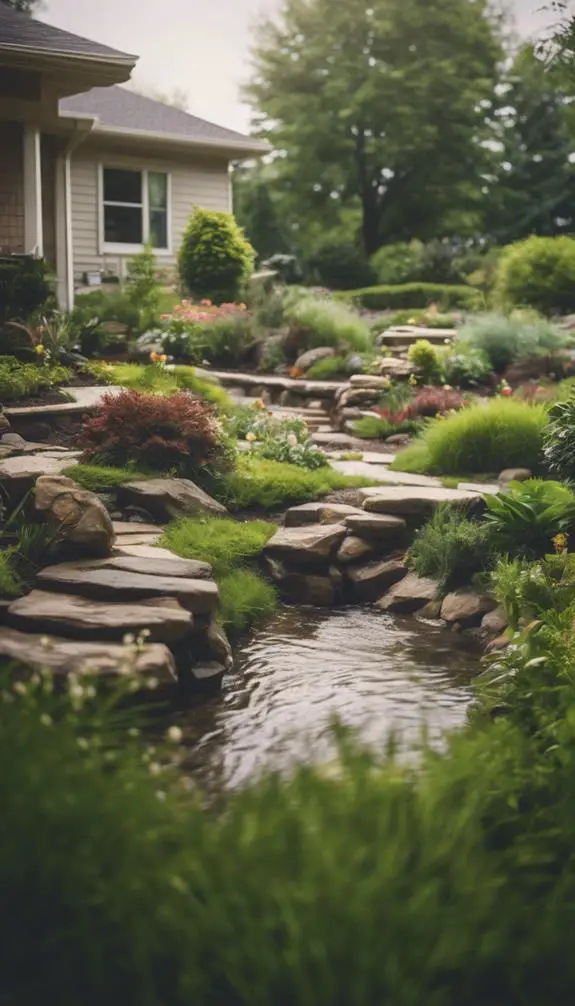
Proper drainage and water management are essential components of a well-designed backyard, as they impact both aesthetics and functionality.
You'll want to ponder the water table, or the level below which the ground is saturated with water, to guarantee that your yard doesn't become waterlogged.
Storm runoff, which occurs when rainfall flows over the ground, can also cause erosion and damage to your landscape.
To mitigate this, incorporate features like swales, rain gardens, or permeable pavers into your design.
These elements will help direct water away from your home's foundation and prevent puddles from forming.
Maximizing Natural Sunlight
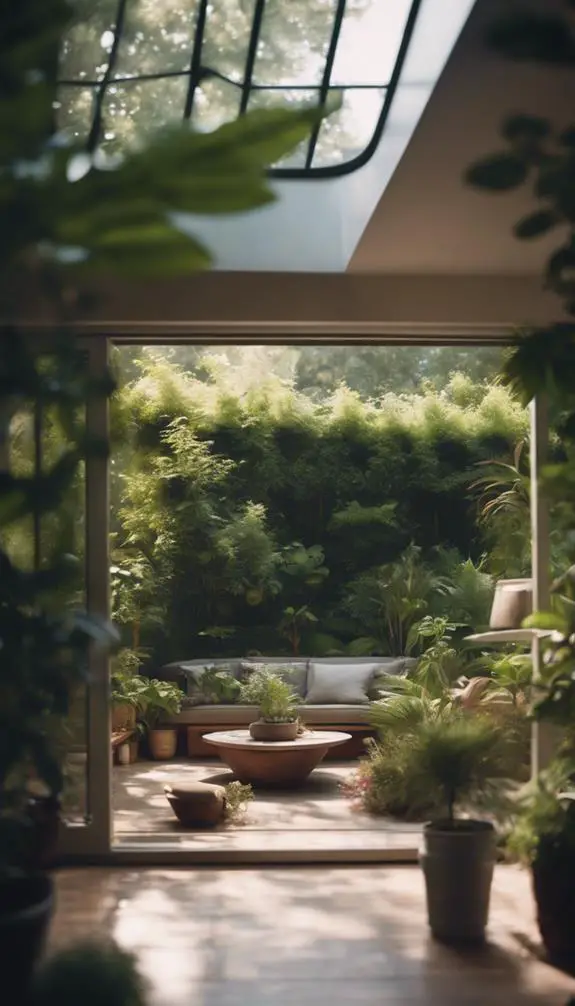
One of the most critical factors in creating a thriving backyard oasis is harnessing natural sunlight.
To maximize sunlight, you'll need to understand the daily rotations of the sun and its patterns throughout the year. Observe how sunlight enters your yard at different times of day and during different seasons.
Identify areas that receive direct sunlight and those that are shaded. Use this knowledge to strategically place plants, seating areas, and other features.
For example, place plants that require full sun in areas that receive six hours of direct sunlight, while shade-loving plants thrive in areas with filtered light.
Creating a Sense of Flow

As you lay out your backyard design, step back to visualize the flow of traffic and the relationship between different areas.
You want to create a sense of flow that guides visitors through the space. Visual pathways, such as curved lines, help direct the eye and create a sense of movement.
Consider the flow of traffic between areas, like from the patio to the garden. Use curved lines to create a sense of fluidity, rather than abrupt shifts.
This will create a cohesive and harmonious design. By carefully planning the flow of your backyard design, you'll create a space that's both functional and aesthetically pleasing.
Adding Focal Points and Accents
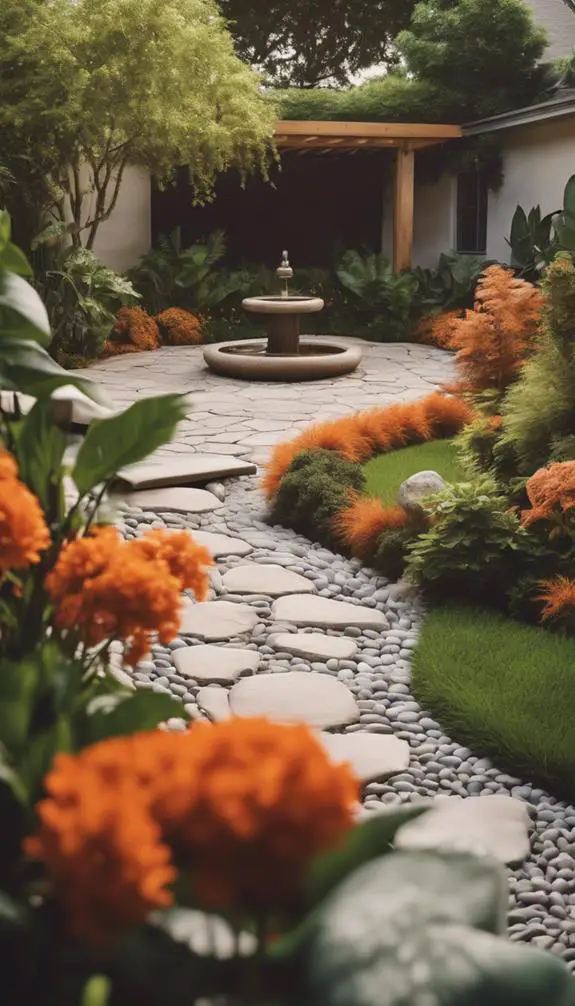
Incorporating focal points and accents into your backyard design draws the eye to specific areas, creating visual interest and depth.
You can create visual anchors using statement pieces like sculptures, fire pits, or water features. These anchors draw the eye to a specific spot, creating a sense of visual hierarchy.
Decorative screens can also be used to add accents, providing a subtle yet effective way to add texture and visual interest. Consider using screens to section off areas or create a sense of mystery.
Incorporating Sustainability Features
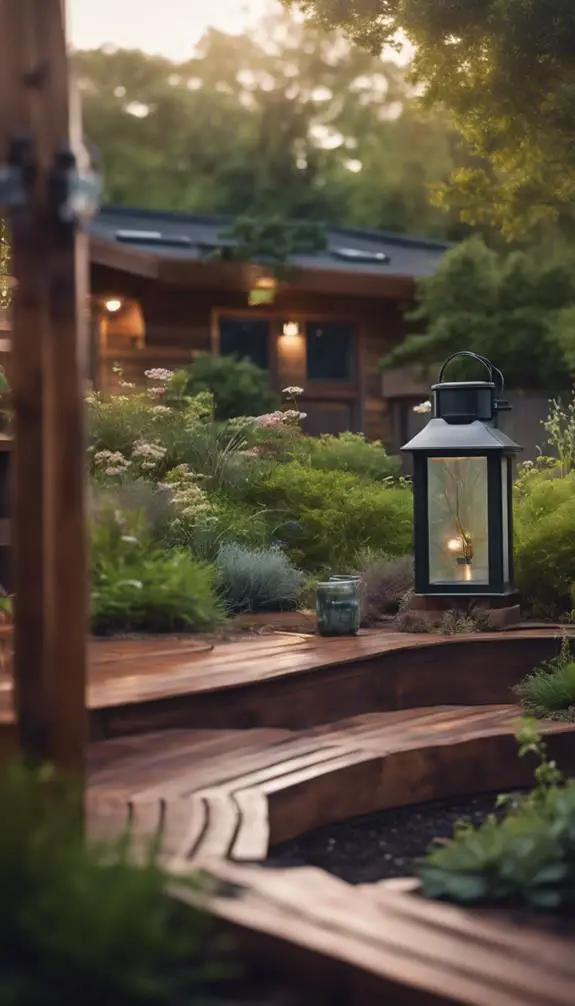
You're likely enthusiastic to create a backyard oasis that not only looks stunning but also does its part for the environment.
By incorporating sustainability features, you'll reduce your ecological footprint while enhancing your outdoor space. Consider installing a green roof, which provides insulation, reduces stormwater runoff, and creates a habitat for wildlife.
Another eco-friendly option is rainwater harvesting, where you collect and store rainwater for irrigation, toilet flushing, or washing machines. This reduces your potable water consumption and lowers your water bill.
Strategically place rain barrels or cisterns to collect rainwater, and integrate them into your landscape design for a seamless look. By incorporating these sustainable features, you'll create a backyard oasis that's both beautiful and environmentally responsible.
FAQs
How Do I Handle Neighbors' Objections to My Yard Design?
When facing objections, you'll navigate neighbor diplomacy by addressing boundary issues directly, listening to concerns, and offering compromises that respect their views while defending your design vision, ultimately finding a mutually beneficial solution that respects both parties' needs.
Can I DIY My Backyard Design or Do I Need a Professional?
You're wondering if you can DIY your design process; with budget constraints, it's possible, but consider your skills, time, and desired outcome, as a professional can optimize space, guarantee permits, and bring innovative ideas to life.
What Are the Benefits of Using a 3D Design Software?
You'll access a new level of design precision with 3D software, allowing you to explore virtual tours and enjoy design flexibility, making adjustments in real-time to visualize your perfect space before breaking ground.
How Do I Ensure My Yard Design Is Accessible for Elderly or Disabled?
You guarantee accessibility by incorporating age-friendly landscaping, featuring wheelchair pathways with gentle slopes, wide clearance, and slip-resistant surfaces, allowing easy navigation for elderly or disabled individuals, while also considering seating areas and rest stops.
Can I Change My Backyard Design Once It's Already Been Built?
You can adapt your design as needs evolve, embracing design evolution through phased implementation, where you strategically update and refine your space in stages, ensuring a seamless shift to a more functional and aesthetically pleasing environment.
Conclusion
You've successfully planned a backyard design layout that harmoniously integrates your needs, budget, and site conditions. Your outdoor space now features functional zones, balanced hardscapes and softscapes, and ideal natural sunlight. A sense of flow guides visitors through the space, while focal points and accents add visual interest. Sustainability features minimize your environmental footprint. With a clear vision and realistic expectations, you're ready to bring your design to life, transforming your backyard into a functional, beautiful retreat.



